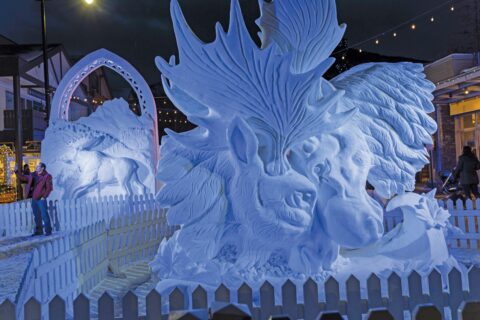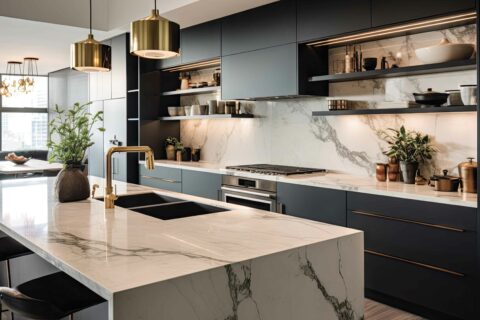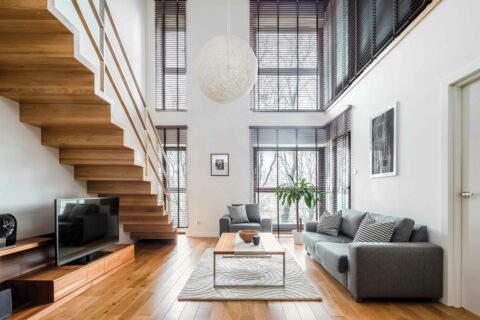Living in the mountains means connecting with the nearby wild spaces. So how do you make sure your home has minimal impact on the surrounding natural world? We interviewed Jodi Conuel, Shift Program Co-ordinator at the Biosphere Institute of the Bow Valley, to find out some of the best ways to make your home more sustainable by reducing household energy and increasing energy efficiency.
Q. What are some of the best ways people can make their homes more eco-friendly?
There are many ways to improve the energy efficiency of your home. I always find that the best place to start is with a home energy audit. An energy audit is an assessment that helps you learn how you use energy in your home, determine where it’s being wasted and identify opportunities for efficiency upgrades. During a professional energy audit, an energy auditor analyzes your energy bills, completes visual mechanical inspections, and may use special equipment, such as a blower door and an infrared camera, to detect sources of energy loss. An energy audit will provide you with a comprehensive home energy report that shows which energy efficiency upgrades are best for your home and your potential energy savings.
There are two different kinds of energy efficiency upgrade; A Deep Energy Retrofit, is the holistic renovation of an existing home that results in a profound reduction in energy consumption. An energy efficiency upgrade or minor retrofit, target “low-hanging fruit” – modifications that are low-cost, easy to implement and that offer good value for the money vs effort invested.
Deep energy retrofits might include:
- Replace your windows and doors. Energy efficient windows are an important consideration for both new and existing homes. Heat gain and heat loss through windows are responsible for 25%–30% of residential heating and cooling energy use.
- If you are selecting windows for new construction or to replace existing windows, it’s important to choose the most efficient windows you can afford that work best in your climate.
- If your existing windows are in good condition, taking steps to reduce the energy loss through windows can make your home more comfortable and save you money on energy bills.
- Increase your insulation and seal up leaks in your buildings envelope, the building envelope includes all the building components that separate the indoors from the outdoors. Building envelopes include the exterior walls, foundations, roof, windows and doors. A high-performance envelope reduces heat transfer in both directions, which decreases cooling loads during summer and heating loads during winter.
- New constructions provide the best opportunity to deploy a high-performance building envelope, since it can be built into the project.
- A major renovation also provides an excellent chance to improve insulation and airtightness.
- Install a solar PV system and generate your own electricity. Solar power makes good financial sense and it is a reliable way to offset your electricity use from the grid. Saskatchewan, Alberta and British Columbia have some of the best solar potentials in Canada guaranteeing a consistent source of sunshine for your system. Not only can solar panels power your home but excess electricity produced can be exported to the grid for a premium where you receive a credit against future use. Check out Bow Valley Powers Solar Club, you can receive up to 22c per kw exported onto the grid!
- Upgrade your heating and hot water system to a 95% efficient system. The latest boilers, gas furnaces and oil furnaces are ultra-efficient, they’re designed to easily replace your existing heater. There are, however, alternatives:
- One of the most energy-efficient home heating system options is the heat pump system. They don’t use fossil fuel at all. Instead, they intake heat from the air (air source) or ground (geothermal), which is delivered to the home via an electric pump. This type of system can also draw cool air and work as an air conditioner in summer. Both types are suitable for existing homes although air-source heat pumps are easier and less expensive to install because they don’t require underground excavation.
- If you already have an existing radiant floor, forced-air, baseboard hot water system a solar thermal system may be a great way to upgrade it to be more efficient. Solar collectors are mounted on the roof of a house and connected to an indoor water storage tank. Pumps circulate the water from the tank to the solar collectors to be heated and pumped back to the tank to distribute the hot water to warm the house.
- Install a heat recovery system once you have properly insulated and sealed your homes building envelope. A HRV is a mechanical ventilation device that helps make your home healthier, cleaner and more comfortable. It does so by continuously replacing stale indoor air with fresh outdoor air. HRVs are set apart from other mechanical ventilation devices. Their ability to exchange heat between the supply and exhaust air streams reduces the cost of heating or cooling the healthy fresh air circulating through the home. HRVs are sometimes called air-to-air heat exchangers because they preheat or cool incoming air using exhaust air.
Q. What are some simple or cost-effective things people can do now to make their homes more sustainable?
A. Feeling a little strapped for cash? You might be able to identify some problem areas on your own:
- Check for drafts. To check for air leaks, do an inspection around each door and window inside and out. Look for large gaps and holes around the frames. You should also check for leaks around areas where pipes and cables, such as your gas and hydro lines, enter your home and around the foundation of your property. To fix drafts use spray foam and caulking to fill holes and cracks. Adding foam or rubber seals around doors and windows can also be beneficial. Doors and windows that don’t sit or close properly should be looked at by a professional.
- Check if you have enough insulation in your walls and attic. If you have access to your attic go up and take a look. If you can see the top of your joists you don’t have enough insulation. An attic should have a minimum R-value (the measurement in which insulation is rated) between 50 and 60. This works out to about 16 inches of loose-fill insulation or three layers of R-22 rated batt insulation. To find out if you have gaps in the insulation behind your walls you’ll need a thermal imaging camera. (You can borrow one from the Biosphere). If you find you are lacking insulation in your walls your best bet is to a call a professional to come and blow loose-fill insulation into your wall cavities. This is much cheaper and less messy than removing your existing drywall/plaster to completely replace the insulation you already have.
- Inspect/service your home mechanical equipment. Call a professional to service your heating and hot water system annually, this will keep them running more efficiently and help avoid premature failures.
- Monitor your electricity usage. Monitoring your electricity consumption will let you know if there are any issues with your appliances or electronics. It will also help you detect any energy hogs, such as televisions and cable boxes, that waste power while even in standby mode. Drop by the Biosphere Institute and borrow a Kill-A-Watt meter.
- Lower your electricity usage:
- Using power bars with timers or unplugging devices during peak hours can easily reduce your electricity consumption.
- Areas around appliances like refrigerators, freezers and clothes dryers, should be kept cleaned so they run at optimal performance. Check the manufacturer recommendation of these devices for adjustments that can be made to use less energy.
- Devices such as laptop computers, TVs, video game machines and many other electronics continue to draw power, even when they’re not in use. Completely unplug them, or connect multiple devices into a power bar and turn them all off at once. ‘Smart’ power bars that automatically limit power use by unused devices are also now available from many electronics retailers.
- Check the built-in settings for a power or energy saver option. These settings will help save energy by reducing screen brightness, going into sleep or hibernation mode when not in use, and limiting background processes and apps. Be sure to shut off computers when they’re not in use for extended periods of time. Keep accessories like printers or scanners turned off until you need them.
- Energy efficient LED bulbs use as much as 85% less energy than traditional incandescent bulbs. A standard 60 watt incandescent light lasts for about 1,000 hours, while new, high quality 9 watt LED bulbs have lifespans of up to 25,000 hours.
- Run washing machines with full loads and use cold water for washing and rinsing instead of warm or hot water. Washing clothes in cold water is one of the most effective ways to reduce your water heating bill.
- Clothes dryers are one of the largest consumers of electricity in your home. Use a drying rack whenever possible, or make sure to run the dryer with a full load (but be careful not to overfill the dryer, as this limits air flow and drying effectiveness). Be sure to clean the lint filter between loads. Restricted airflow will decrease the dryer’s effectiveness and is a serious fire hazard!
- If you’re replacing old appliances, be sure to check for the ENERGY STAR® symbol. It identifies top energy performers that will provide long-term energy and cost savings.
- For the most part modern dishwashers are faster, more hygienic and more friendly to the environment than handwashing your plates. Making sure you do full loads every time and don’t pre-rinse! By using the air-dry setting on your dishwasher, you can save between 15 to 50% of the energy consumed by your dishwasher. If there’s not such a setting, you can simply open your dishwasher after the wash cycle to let your dishes air-dry.
- Install a programmable or smart thermostat to give yourself more control over your heating demands. Consider zoned heating if you are replacing an older system. With zoned heating, the homeowner can use multiple programmable thermostats to specify different temperatures in different zones of the home. Such a system offers comfort benefits as well as money and energy savings. Zoned heating is estimated to reduce the average household’s annual electricity consumption by up to 30 per cent.
- Switch your utility provider to a supplier of renewable energy – Bow Valley Power or Bullfrog Energy are just a few examples.
Q. Can you touch on the importance of striving towards sustainable homes in ecologically important areas like the Bow Valley?
A. The Bow Valley is already feeling the impacts of climate change. Smoke from forest fires has filled our skies in recent summers, with Calgary recording a record number of smoky hours in 2017, then promptly breaking that record in 2018. Climate models predict the average annual temperature in the Bow Valley will increase by 1.9°C in the next 30 years. And by that time, rain will make up more winter precipitation than snow. Mountains are among the most sensitive ecosystems to climate change and are being affected at a faster rate than other terrestrial habitats. Climate impacts form an important threat to mountain ecosystem services and the populations depending on them, and have considerable effects on glacial water resources.
The Bow Valley is already feeling the impacts of climate change. Smoke from forest fires has filled our skies in recent summers, with Calgary recording a record number of smoky hours in 2017, then promptly breaking that record in 2018.
—Jodi conuel, biosphere institute of the bow valley
We are sure to experience further changes to our climate in the decades ahead—the result of past greenhouse gas (GHG) emissions. There is a time lag between GHG emissions and when we see the impacts as the planet responds. How much the climate will change beyond the next few decades depends on how much and how fast global GHG emissions are reduced from current levels. We have a responsibility to protect our fragile mountain home and do everything we can to reduce our household carbon footprints. With energy use in buildings accounting for over 50% of Canmore’s greenhouse gas emissions, increasing the energy efficiency of buildings is crucial to meeting the Bow Valley’s climate action goals and lessening our impact.
As a tourism town (usually) flooded with eager tourists we have the opportunity to lead by example with an international stage.
Q.Are there any resources for people looking to build sustainable homes in the Bow Valley?
Check out the Bow Valley Sustainable Building Summit webinars and Bow Valley Sustainable Building Summit online trade showcase. The showcase highlights some local businesses who operate in the energy efficiency space.
Passive House Alberta is a non-profit foundation offering education and awareness tools for all Albertans including government, builders, developers, architects and homeowners. Passive House is an energy efficiency standard. It is not a single technology, but a proven method of combining materials and various design elements into a structure to produce superior energy performance.
Q. Are there any resources for people who’ve purchased an existing home and want to make it more sustainable?
A. More information can be found on the Shift resource section of our website and from our residential energy efficiency workshop series.
For a list of local energy auditors, click here.
Learn more about the benefits of energy efficiency, here.
Q. If you could only afford to do one thing to make your home more sustainable, what would that be?
A. Get a professional home energy audit. Ultimately, what you need to do to your home is different to what I need to do to mine. A home energy audit will lay it out for you, exactly what you need to do to improve your home and rank these steps in order of importance. This way you know what to tackle first, which would be your biggest problem and have the potential to increase the sustainability of your home the most.
Statistics show that space heating made up 61% of residential energy use in 2016, if you include water heating this goes up to 80%. If you don’t want to pay for a professional energy audit I would suggest upgrading your heating and hot water system to a more efficient system. New systems can be up to 98% efficient.
Q. Is there anything else people should know?
A. Waste reduction, water conservation and transportation are other ways to improve the sustainability of your household. If you are interested in learning more you can sign up to our monthly Shift newsletter and get sustainability tips sent straight to your inbox.
Jodi Conuel is a Shift Program Co-ordinator at the Biosphere Institute of the Bow Valley. To find out more about their work, visit their website at biosphereinstitute.org.



